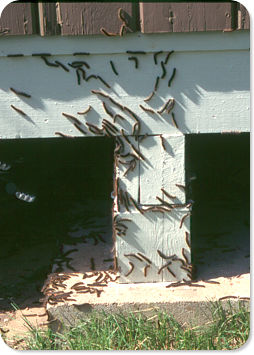 Forest tent caterpillars creepy, not harmful.(Published in the Winnipeg Free Press, Mar. 18, 2001) "To spray, or not to spray: that is the question; whether ‘tis nobler in real life to suffer the mess of outrageous numbers of caterpillars, or to take up aerial spraying against this sea of larvae, and by opposing end their defoliation." It's with apologies to Mr. Shakespeare and some trepidation that I wade into the debate over forest tent caterpillars (FTC's). As a Whiteshell cottager, I endured the great FTC outbreak of 2000. My family was undeterred by the caterpillars that blanketed the park from May until late June. They were gone by July, only the cocoons were left, and the forest had re-leafed completely by mid July, so it wasn't like the whole summer was ruined. I can't say that I enjoyed it, but neither was I disgusted or appalled. A lot of people deprived themselves of being at their cottages or campsites for much of the early summer. I have little sympathy for them and their "entomophobia". Initially, I supported Manitoba Conservation's decision to let the outbreak run its course naturally. However, the more this issue was debated, the more interested I became in the facts behind the controversy. Here's some of what I found out. FTC's are the larvae of the FTC moth, a native species, widespread in North America. Their populations cycle over a 15-20 year period, occasionally exploding to defoliate large areas of forest. The cause isn't well understood, but it may be a predator/prey relationship that simply gets out of balance. Their chief predator is the flesh fly, whose larvae eat the caterpillars. Whatever sets them off, in 2 or 3 years FTC's can multiply to astronomical numbers, up to 10 million caterpillars per ha. But the flesh fly is not far behind, its numbers ballooning along with its main food. In a year or two the flesh fly and other parasites and diseases overtake the FTC's and send their numbers crashing back down. Is there damage to the forest ecosystem? Not in the long term. Aspens and other deciduous trees can be weakened by several years of defoliation, but unless factors such as drought or other pests compound there is little threat to the trees. The temporary hardship imposed on the deciduous trees actually benefits young conifers and forest wildflowers which receive extra sunlight and fertilizer (FTC poop). No North American jurisdiction employs pesticide programs against forest tent caterpillars for "forest protection" purposes. That's not to say, however, that a control program would not be effective. The biological agent, Bt (Bacillus thuringiensis, a bacterium) is used to control other defoliating caterpillars. Studies have shown that this short-lived agent is effective and relatively environmentally-friendly, with little effect on overall insect biodiversity. Therefore, a Bt spraying program isn't such a bad thing, biologically speaking. Nor is letting the FTC outbreak run its course. So, personally, I don't see this as a biological issue. Enter the humans and their esthetic and economic factors. The outbreak had an undeniable effect on park usage. I enjoyed the increased peace and quiet in May and June, but local businesses felt the pinch. And we were all left with a fair bit of work to clean up and rid our cottages, sheds, bicycles and boats of the innumerable cocoons left behind. What would be the cost of a control program? Aerial Bt aerial spraying costs about $50/ha. The Whiteshell District Association contends it would be feasible to spray cottage subdivisions and a buffer area for less than $150,000. To their credit, they suggest that individual cottagers pay for the program with a $40 service fee. However, that leaves Manitoba Conservation to pick up the tab for the rest of the high use areas of the park. And, of course, if the province agrees to spray, they set a precedent, and not just for the Whiteshell. This could end up being a moot debate anyway. It may already be too late to develop a program to spray this year. And, with or without spraying, the problem will go away by itself in a year or two. Personally, I think there are more pressing things for our government to be concerned with, but if you feel strongly about this issue, one way or the other, then let them know what you think. That's your right. Thanks for reading! Got to the: < Previous Column | What's Outdoors Front Page | Next Column >
|
||
|
For more on this topic, here's some articles in NatureNorth.com: |
||
| You can help NatureNorth produce more great articles with a secure donation through PayPal. Our Google Adsense ads pay our server costs, but that's about it. To learn more follow this link: Support NatureNorth. Thank-you! | |
Return to the: NatureNorth.com Front Page
Or pick a seasonal issue to visit:
